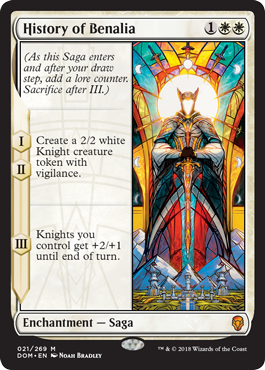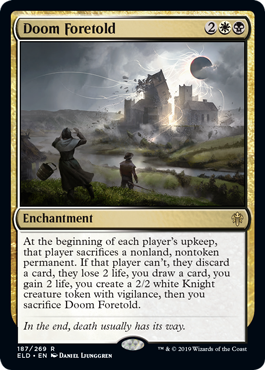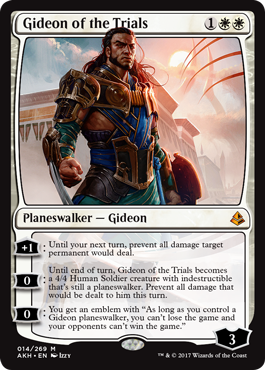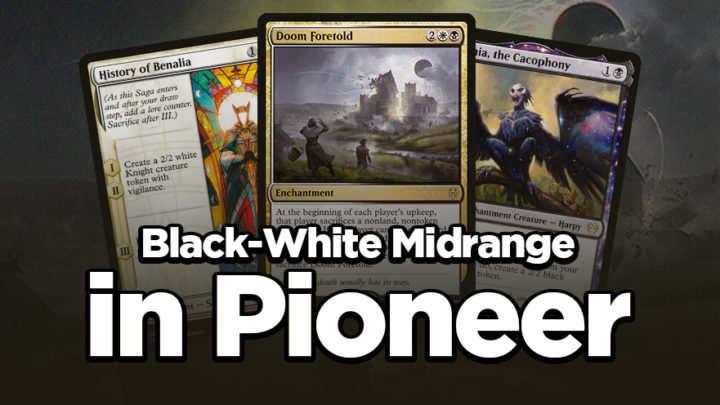Pioneer was the hot new thing at the end of 2019, and now we’re living through its first big test as a format. As tuned, consistent combo lists like UB Inverter and Lotus Breach take a firm grip on the metagame, many players seem to feel the format is losing the creative spirit that its name evoked. But even with no bans coming in the near future, some enterprising brewers still feel there’s gold left to mine outside the established top decks of Pioneer. One such player is Zack Brady (@Brady_MTG) who recently set out to build around a card he felt has been overlooked: History of Benalia.
After reading about his successes with the brew in an event report, I asked Zack if he could explain his approach to the emerging BW archetype, the Pioneer meta, and brewing Constructed decks in general.
A NEW CHAPTER OF HISTORY
Some brewers find themselves working outside the meta because of a deep affinity for their particular archetype, but Brady is not a dyed-in-the-wool Orzhov player. Rather, he went looking for a viable BW shell after the release of Theros Beyond Death and the groundbreaking draw spell Treacherous Blessing. He had already been thinking about how to best harness History of Benalia, which he describes as “the Lingering Souls of the format: little bit on the fair side, can win the game on its own, is super high on raw value generated.” Now, any potential fair midrange deck could offset one of its fatal weaknesses by packing a playset of draw-threes; the time seemed right to sleeve up the powerful saga.

Having access to efficient card draw in a color combination famous for its removal pushed a lot of players towards control. But Brady says he knew that was too fair, even before Breach and Inverter had started to drive up the pace of the format. “Instead, I wanted to push the curve lower and I found a good balance between disruption and pressure. Most of all, I felt like it attacked the Inverter match-up at an angle (waves of History tokens) that was difficult for them to fight through.”
To ensure he could keep the token pressure extra-consistent, Brady added Aphemia, the Cacophony and Tymaret Calls the Dead. Inherent synergies with sagas and enchantment-based removal led to the inclusion of Doom Foretold, and the deck was taking shape!
The strategy really plays to the strengths of BW, and History specifically. With the token-making cards providing an efficient, resilient combat threat at low CMC, a large portion of the deck can be given over to terrific BW removal. A single History of Benalia threatens ten damage over the two turns it stays in play, and the potential for multiple copies cast back-to-back is absurd. Brady also emphasizes the power of a deck which can always find fuel for Aphemia, including cycling a Cast Out turn one to curve into her. This is part of the justification for Tymaret Calls the Dead, which is a great follow-up to the legendary harpy, but otherwise pretty mediocre. “It’s my pick for the most replaceable card in the deck long-term,” Brady says. “As soon as we find a better enchantment that puts itself in the bin to feed Aphemia, that’s probably where we move to.”
FORGE YOUR OWN PATH
Playing Tymaret Calls the Dead in Pioneer already requires a certain level of boldness in the face of conventional logic, but Brady is very open to doing what feels right for his vision of the deck. Forgoing Fatal Push entirely to play a full clip of Final Payment sounds mad given that Push and Thoughtseize are viewed as the main rewards for playing black. But Brady is confident the meta will exonerate him; the deck has plenty of ammunition against creature aggro, and turn one mana dorks are on the downswing. Having an unconditional kill spell for both enemy threats and his own Treacherous Blessings is a slam dunk in his eyes.
Final Payment taxing the same set of resources as he needs to fuel Doom Foretold does lead to interesting decisions, but the flexibility to sacrifice a creature token or just pay five life gives enough room to play around it. Brady claims he has even turned this interaction advantageous by using Doom Foretold to fuel a Payment where Doom would otherwise be force-sacrificed to itself; having what he fondly refers to as “the bad stuff” trigger on you mostly ends up a slight positive, anyway!

If that sort of line sounds loose to an average listener, Brady doesn’t seem to mind. To him, that’s simply the kind of attitude you need to register a brew for competition in the first place. Testing can only take you so far when you don’t have the benefit of the online hive mind to statistically optimize your list.
“Everything anyone does on their own has a small sample size,” he says. “Too small to derive actual relevant data from. In the end, it all comes down to a gut check. I have a pretty good gut when it comes to powerful synergies and interactions and I’m very good at playing decks like the one I’ve created here.
“I think it’s important for brewers to be honest with themselves. Toss out the W/L numbers. Get a good handle for what your deck is trying to do in each match-up and then figure out where your deck struggles… constantly re-evaluate what each card does in each match-up and if it’s the best solution for the job. That math constantly changes and it takes a while to get a good feel for it.
“You already have a leg up on your opponent when you bring a brew to the table because you know what they are doing, but they do not know exactly what you have in store. You better use that to your advantage. Brewing a deck is as much about knowing your deck as it is about knowing the field and how each deck might try to pivot to interact with you.”
It’s hard to quantify the free wins you gain across a tournament from players underestimating your aggressive potential or making bad mulligans against you, but it’s definitely a non-zero number. Brady’s event report fondly makes note of Inverter players boarding in ineffectual Ashioks to hit Gideons which aren’t there, while his deck is able to add a huge weapon in Lost Legacy! This unpredictability could offer a way for players to break up the dominance of Pioneer’s calcifying top tier.
ORZHOV ON THE RISE
While Brady has so far been able to capitalize on the advantages of playing an unknown deck, things may not necessarily stay that way for long. The recent big wave of paper Pioneer events has seen a number of players pilot rogue BW decks to notable results, giving the sense that the color combination may provide the foundation for a strong meta contender. The complication here is that the BW decks putting up these finishes don’t really look like they’re in the same archetype at all!
There have been occasional Orzhov lists popping up in MTGO 5-0 dumps since the format’s inception; very few card choices are consistent outside of Thoughtseize. Certainly none of them resemble Zack Brady’s enchantments-and-tokens list, even if they all ostensibly fall under the banner of “BW Midrange.” Raja Sulaiman sleeved up a completely different list under that same name and pulled out an 8-2 record at PT Phoenix. His version of BW looks like a more conventional pile of creatures, Gideons and removal, although he also skews the curve low, with a whopping sixteen one-mana spells allowing for high-tempo starts.

Ken Yukuhiro’s much-celebrated deck from PT Nagoya is also overloading on one-mana plays to steal a march on opponents, but that list is completely different again: an all-in aura synergy deck using new support cards from Theros Beyond Death. But as much as these decks are taking different approaches to BW, they do hit some common notes. Sulaiman’s list, like Brady’s, recognizes the power of History of Benalia. Yukuhiro had also identified Aphemia’s potential as a build-your-own Goblin Rabblemaster. As more players are inspired to test variations on these lists, does it seem possible to Brady that we will eventually arrive at a single, “best” Orzhov list for Pioneer?
“I think it’s possible with enough testing… but I also think as the meta shifts there are many routes you can go, and that will keep people brewing… Theros made people less timid to play white decks in general. This breathed new life into people testing white decks of all sorts, and I think many of these BW decks really center around History of Benalia and how best to use it.”
For his part, Brady is taking some cues from Raja Sulaiman’s list, adding Knight of the Ebon Legion and Mutavault to play off History of Benalia. He’s also made room for Gideon of the Trials as a main deck hurdle for combo decks which still fits into the beatdown game plan.
STATE OF THE GAME
Brady’s current list shows an obvious respect for the threat posed by UB Inverter and Lotus Breach, Pioneer’s current villains. But does he think the meta can be solved by the right brew?
“I think that players on average are too quick to call for bans. However there are instances where aggressive management is necessary, and I feel like people overestimate the format’s ability to adjust to things… we hammered many decks and brews against [Breach & Inverter] and still came out with those two decks being above the rest. The PT and GP data from that weekend carry that out. There isn’t a ‘wait for the meta to adjust to them’ phase for these decks since they had a target on their back for the entire weekend and still came up on top.
“Combo decks that are good at fighting through hate pieces and require you to lock into a race-or-lose mentality often end up needing a more aggressive position when banning and I do think we’ll see that in a B&R soon.” In the meantime though, he intends to keep pioneering BW Midrange, in the truest sense.
“It’ll be interesting to see where things go from here for sure, and whether Treacherous Blessing gives BW decks in particular the engine to keep up with things like Treasure Cruise and Dig Through Time.”
Many thanks to Zack Brady for this interview. You can discuss BW decks with him on Twitter (@Brady_MTG) and Discord (BradyMTG#0210).

Tom’s fate was sealed in 7th grade when his friend lent him a pile of commons to play Magic. He quickly picked up Boros and Orzhov decks in Ravnica block and has remained a staunch white magician ever since. A fan of all Constructed formats, he enjoys studying the history of the tournament meta. He specializes in midrange decks, especially Death & Taxes and Martyr Proc. One day, he swears he will win an MCQ with Evershrike. Ask him how at @AWanderingBard, or watch him stream Magic at twitch.tv/TheWanderingBard.

